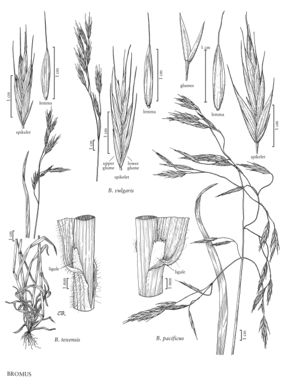Difference between revisions of "Bromus texensis"
imported>Volume Importer |
imported>Volume Importer |
||
| Line 39: | Line 39: | ||
|publication year= | |publication year= | ||
|special status= | |special status= | ||
| − | |source xml=https://bitbucket.org/aafc-mbb/fna-data-curation/src/ | + | |source xml=https://bitbucket.org/aafc-mbb/fna-data-curation/src/200273ad09963decb8fc72550212de541d86569d/coarse_grained_fna_xml/V24/V24_302.xml |
|subfamily=Poaceae subfam. Pooideae | |subfamily=Poaceae subfam. Pooideae | ||
|tribe=Poaceae tribe Bromeae | |tribe=Poaceae tribe Bromeae | ||
Latest revision as of 16:22, 11 May 2021
Plants annual. Culms 30-70 cm, erect or spreading; nodes 3-5, pubescent. Sheaths densely pub¬escent to pilose; auricles absent; ligules 2-3 mm, lanceolate, pub¬escent, obtuse, erose; blades 7-20 cm long, 3-7 mm wide, flat, usually pubescent to pilose, rarely glabrous. Panicles 8-15 cm, open, drooping; branches ascending to spreading. Spikelets 20-30 mm, elliptic to lanceolate, terete to moderately laterally compressed, with 4-7 florets. Glumes glabrous or hispidulous; lower glumes 6-9 mm, 1-veined; upper glumes 8-10.5 mm, 3-veined, usually acute, rarely mucronate; lemmas 9-15 mm, lanceolate, rounded over the midvein, glabrous, sometimes scabrous, apices subulate to acute, entire; awns 4-8 mm, straight, arising less than 1.5 mm below the lemma apices; anthers 3-5 mm. 2n = 28.
Discussion
Bromus texensis grows in openings in brushy areas on rocky ground. It is rare, found only southern Texas and northern Mexico.
Selected References
None.
